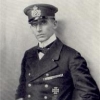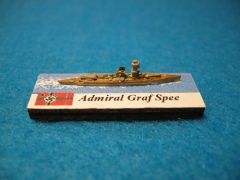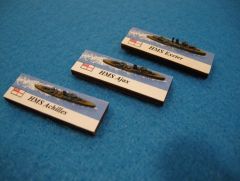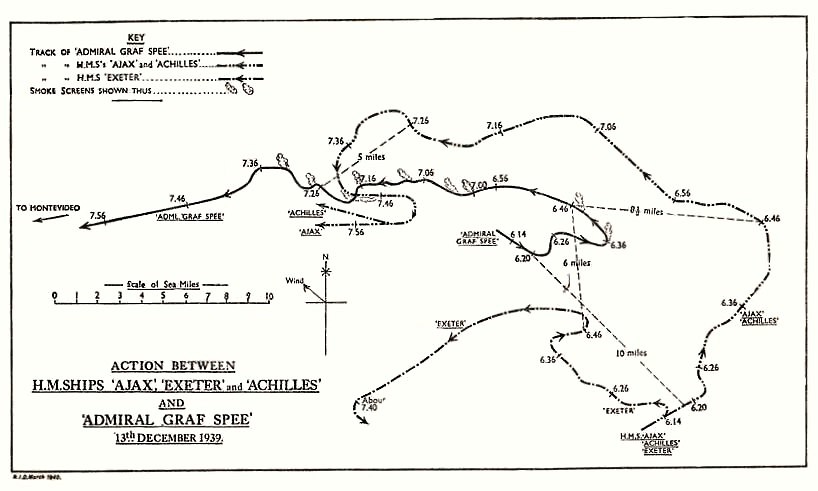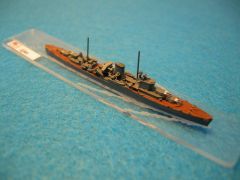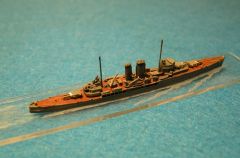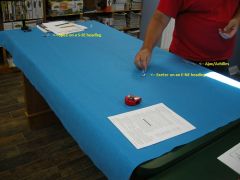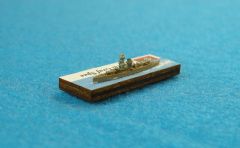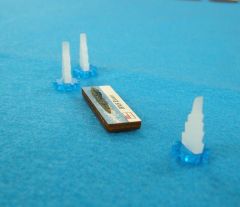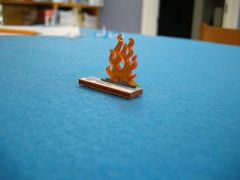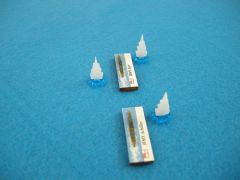The engagement that has come to be known as the Battle of the River Plate stands as the first significant action between the Royal Navy and the Kriegsmarine during WWII. It would be the initial clash of their two opposing doctrines, and for the German Navy an experience which would haunt it for the next 5-1/2 years.
The intervening years seems to have only sharpened the mythology that has evolved around this battle. It was a clash between a contrived “pocket-battleship”, the German Panzerschiff, the concept for which emerged out of the post-WWI treaty limits, and three lighter antagonists, all of which it was designed to defeat handily. I have excerpted the following recount of the cruise of Graf Spee from Geoffrey Bennett’s excellent Battle of the River Plate, published in 1972, and various other sources.
Admiral Graf Spee, completed in 1936, was the third of the three Deutschland-class Panzerschiff. Deutschland and Admiral Scheer had been completed in 1933 and 1934 respectively. The class had a standard displacement of some 12,100 tons, with primary armament of six 11-inch guns in two turrets which were designed to be able to withstand up to 8-inch shells. Powered by diesel engines, the class had a cruising radius of 19,000 miles and a maximum speed of 26 knots. Of Britain’s capital ships (ships with guns larger than 8-inch), only the battlecruisers Hood, Renown and Repulse had the speed to run them down. They were conceived and built as commerce raiders, and as such Graf Spee passed between the Faeroes and Iceland on August 24, 1939.
With orders to steer clear of all shipping routes, Graf Spee and her supply ship Altmark passed to the west of the Cape Verde Islands on September 3, the day Britain and France declared war. On September 8th they crossed the equator, and by the 13th had taken up position undetected in the middle of the South Atlantic. On the 11th they had been extraordinarily fortunate to have avoided the 8-inch cruiser HMS Cumberland, enroute from Freetown to Rio de Janeiro.
Deutschland had sailed three days after Graf Spee, taking up a position to the south of Greenland.
Graf Spee’s captain was career officer Hans Langsdorff. Ironically he had grown up in Dusseldorff, where he was a neighbor of the von Spee family. It was their influence that led to his choice of a naval career. He served in the High Seas Fleet and saw action at Jutland. After the war he served in a number of administrative posts before being posted aboard Graf Spee in 1936 as a member of the staff of Admiral Boehm. Langsdorff was appointed her commander in October 1938.
On September 26, 1939, Graf Spee was released for operations in the South Atlantic. Langsdorff headed for the coastal shipping lanes off Brazil, intending to disrupt British food-stuff shipments originating from Argentina. On the 30thGraf Spee sank her first victim, SS Clement. With the alarm given, Langsdorff directed his ship eastward, intending to disrupt the lanes between southern Africa and Europe. There on October 5th he sank SS Newton Beach. Reports of the attack reached HMS Cumberland later that day, but no message was sent to CinC South Atlantic at Freetown as Captain Fallowfield, commander of Cumberland, wished to not reveal his presence in the area.
Graf Spee continued her activities through October 10th, sinking a number of ships. On the 12th she refueled from Altmark. Langsdorff, having captured a copy of the Admiralty’s secret code for British merchant ships, headed south where she encountered SS Trevanion. Trevanion was stopped, boarded and scuttled, but not before she radioed a distress signal which was picked up by the liner Llanstephen Castle, which relayed the message to Freetown. Having refueled again on October 29th, Graf Spee rounded the cape on November 3rd and entered the Indian Ocean.
After ten days with no sightings, Langsdorff sailed north where he sank a small tanker in the Mozambique Channel. Growing fearful of lingering, Langsdorff returned to the South Atlantic and his waiting area on November 23rd. There he waited for four days making repairs and attempting to disguise Graf Spee as HMS Renown by erecting a third turret and a second funnel, all of wood. Langsdorff refueled again on the 26th, then set off once again for the sea lanes off the western coast of Africa. On December 2nd he sighted the liner Doric Star which was able to send a distress message before being boarded and scuttled. This message was relayed to Freetown. Concerned for his ship’s safety, Langsdorff made the fateful decision to cross the South Atlantic for a position off the Plate.
After sinking SS Tairoa, Graf Spee refueled from Altmark for the last time three days later. Langsdorff transferred most of his prisoners to Altmark, then continued west. On the evening of December 7thSS Streonshalh was encountered and sunk before a message could be sent. From documents captured aboard Streonshalh, Langsdorff was able to determine the optimal position for intercepting shipping leaving the Plate.
Berlin had sent Langsdorff reports indicating that British capital ships were actively searching for him in the Freetown area. They also reported that four British cruisers were off the South American coast between Rio and the Falklands. Langsdorff considered these forces too light individually to be a threat to him, and changed his operational area to be off the river Plate where he had intel that a small convoy was being assembled at Montevideo.
Two days later Graf Spee reached Langsdorff’s targeted area, turning on a south-easterly course. At sunrise he got a surprise…at 0552 on December 13th he received a report of a ship on the horizon, which a quick check of the recognition guide revealed a York-class heavy cruiser, HMS Exeter. Eighteen minutes later, two smaller ships were identified, light cruisers HMS Ajax and HMS Achilles. Langsdorff's assessment that he could individually defeat any of the British cruisers reported in the area was suddenly moot.
At 0600 Graf Spee went to action stations…
Graf Spee:
Edit :: A number of contemporary sources place the Deutschland-class top speed at 28.5 knots, roughly equivalent to a King George V-class BB.



